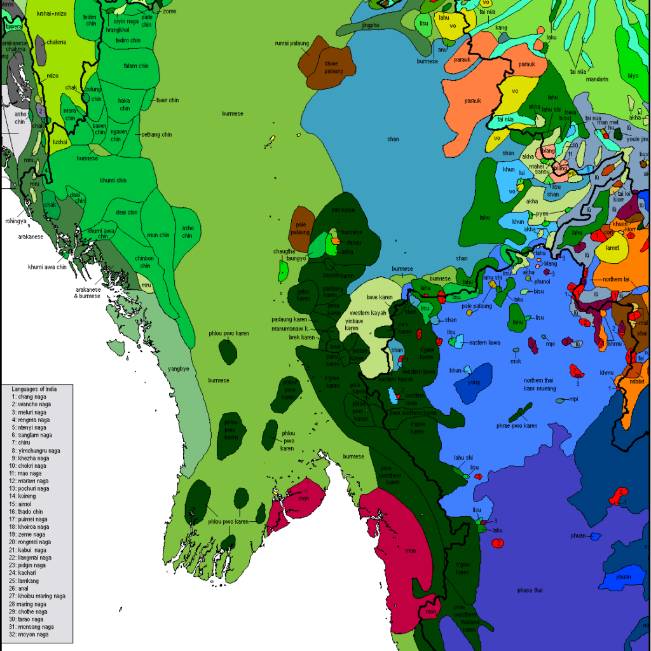Myanmar's 'language problem'

Myanmar is a multi-ethnic country, home to more than 100 ethnic groups who speak over 80 different languages. The two most important language families are Tibeto-Burman (e.g., the national language, Burmese, and the Karen languages and others) and Sino-Thai languages (Shan being the most important among them). There are also Mon-Khmer languages (Mon, Palaung? and others). The Indians and Chinese who immigrated during the colonial period brought their languages. However, I have observed that the children and grandchildren of these immigrants often no longer speak their parent’s native language and communicate with each other in Burmese. Among some of these minorities (such as the Chinese), there are efforts to reintroduce the young generation to the language of their ancestors. The future will show to what extent this is successful. The speakers of Tibeto-Burman idioms make up most of the population – ethnic Burmese (self-designation: Bamar) alone count for two-thirds of the country’s inhabitants!
Burmese is the national language of Myanmar and is used as the language of instruction in all schools in the country. The school teachers are, therefore, mostly Burmese, who can be found even in the most remote places in the country. Very often, they are the only ones of their people in the village, surrounded by locals who don’t speak their language. Quite a few (both locals and foreigners) find this discriminatory. But the fact that a Chin cannot communicate with a Mon in any way suggests a common lingua franca. And that’s, of course, the language of the majority – Burmese! Even the independence-minded Karen people often have to communicate in the unpopular Burmese language. A Karen from the delta cannot understand his fellow Karen from the Karen State. At least, that’s what I’ve been told.
Around 15 years ago, a friend came to Burma to shoot a successful film. One scene was set in a Palaung village not far from Kalaw. It included a conversation between two women who were picking tea leaves. When it was to be broadcast on German television, the station requested to have the conversation translated. Now, we were up the creek without a paddle. But then I had an idea! As I remember, Palaung women can be found on Anawrahta Street in downtown Yangon. They are selling tea and are easily recognizable by their traditional costume. So I went there, spoke to one of them, and asked her to translate the conversation of her fellow tribesmen for me. After some hesitation and for a small fee, she agreed to do so. She watched the scene from the movie and told me, “I don’t understand a single word! These are Palaung from Kalaw; I’m from Taunggyi!” –about a hundred kilometers to the east…
Many ‘well-meaning’ people (including some I know with otherwise reasonable views) want to ‘support’ minorities. They demand that children be taught in their mother tongue, at least at primary school. Starting from middle school, they could switch to Burmese. How generous! As mentioned above, there are over 80 languages in the country. Some don’t even have 100,000 speakers. How do you propose to do that? Should textbooks and teaching materials for primary schools be developed in 80 languages? And by whom?
That’s outrageous nonsense and economically unfeasible in a poor country like Myanmar. Quite apart from the fact that most children don’t get past elementary school, especially in the federal states. I think a Burmese might see this as an attempt to deepen divisions in the country. Assuming that could be done, what happens to such children when they leave their home region? They won’t be able to communicate with others! The question is: what do these ‘helpers’ actually want to achieve? Prevent the minority languages from extinction? I don’t think people start speaking Burmese at home because it is taught at school. Let’s take a look beyond our borders. Indonesia’s population is about five times that of Myanmar. There are many more ethnic groups in that country than in Burma, and they speak about 250 languages. The official language in Indonesia is Bahasa Indonesia. However, it is only the mother tongue of a quarter of the population. Still, no one has a problem using it. Why wouldn’t that work in Myanmar? Because Burmese is not an artificial language like Bahasa? I remember that when I was in elementary school in the 1950s, there were working-class children who spoke Low German. This was generally regarded as the language of the lower class and the peasantry and was ostracized. Children who used it at school were shouted at and sometimes punished by the teachers. And here we come and tell the people in Myanmar that they have to preserve their culture …